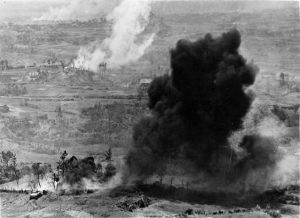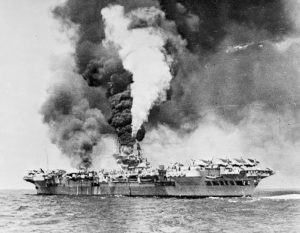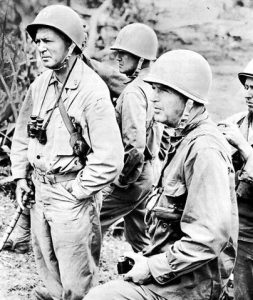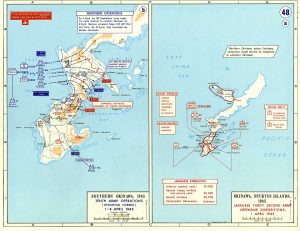Civil War Echoes: The Battle of Okinawa
Today 74 years ago Operation Iceberg, the invasion of Okinawa, got underway as the first of 183,000 soldiers and Marines of U.S. Tenth Army swarmed ashore at Hagushi on the island’s west coast. It was the largest amphibious operation of the Pacific War, and the largest sea-air-land battle in history.
Over the next three months, until combat operations ended on July 2, Tenth Army methodically blasted out the island’s Japanese defenders from their fortifications. Their tactics against the caves and tunnels were called “blowtorch and corkscrew”, depending on how they either burned out the defenders with fire (blowtorch) or sealed the caves with explosives (corkscrew). Offshore, an average of a ship and a half per day was sunk or damaged by Japanese planes using conventional bombing and suicide attacks.

When the fighting was over, 49,000 U.S. ground troops were killed, wounded or missing; another 11,000 casualties were sustained by the fleet. Except for 7,000 prisoners, all of Okinawa’s 120,000 defenders died, along with 82,000 civilians, roughly 20% of the island’s population. Okinawa was the bloodiest battle of the Pacific War, and when considered a full-dress rehearsal for the invasion of Japan, offered a sobering preview of what awaited on the home islands.
The Battle of Okinawa also has several major echoes of the Civil War.
The first, and loudest, echo is that of Tenth Army’s commander, Lieutenant General Simon Bolivar Buckner, Jr. His father was Confederate Lieutenant General Simon Bolivar Buckner, who was a major influence on his son. His father was on the younger Buckner’s mind the night before the invasion: “Tomorrow is Easter Sunday,” he told his diary, “my father’s birthday and the day of my first battle. I hope that I shall be able to look back on it with the same degree of enthusiasm with which I anticipate it . . . turned in early so as to be fresh for tomorrow’s events.” He would be killed on June 18, 1945, by shellfire, the highest-ranking American to die by enemy fire in World War II.

Many men of Tenth Army were aware that they were landing on the same beaches as Commodore Matthew Perry’s expedition in 1853 – a force that included several notable Civil War personalities such as Franklin Buchanan, Jacob Zeilin, and others. During the battle Army troops mounted an unsuccessful search for graves of seamen buried on Okinawa who had died from disease during Perry’s expedition.
Several of Buckner’s units also had Civil War ties. The 17th Infantry of 7th Infantry Division served in all the battles of the Army of Potomac from the Peninsula to Petersburg as part of the Regular Division and later Romeyn Ayres’ Regular Brigade. The 27th Infantry Division was a National Guard formation from New York State; it’s 165th Infantry Regiment was the former 69th New York, of Irish Brigade fame. The division’s 105th and 106th Infantry Regiments between them carried forward the lineage of the New York State Militia units (2d, 7th, 9th, 10th, 13th, 14th, 20th, 23d, and 79th) that saw action during the Civil War.
Lastly, when the Marines captured Shuri Castle, key to the main Japanese defense line, they wanted to raise a flag to signify the event. Some accounts note the only flag handy was the Confederate battle flag. Buckner ordered it replaced, commenting “we are all one country now.”


The Marines warned Buckner that they were under Japanese observation, but Buckner in his uniform including his General’s stars and with a large entourage of staff came forward anyway. A mortar round struck nearby and Buckner was struck in the chest. As Buckner lay dying, a Marine held him and told him: “Don’t worry General, you are going home”.
I first read of the Shuri Castle Rebel Flag raising in Eugene Sledge’s “With the Old Breed.
What a coincidence that you post this article on the same day my buddy gives me a WW2 Japanese type 30 Arisaka bayonet.
I interviewed a few elderly Okinawa veterans while writing for the Bangor Daily News. Their memories focused more on lost comrades than on the direct fighting. I wonder if elderly Civil War veterans ever felt the same way.
I’ve seen in many letters immediately after various battles that there is a focus more on who was killed or wounded than on what happened. Seems to be universal, I think.